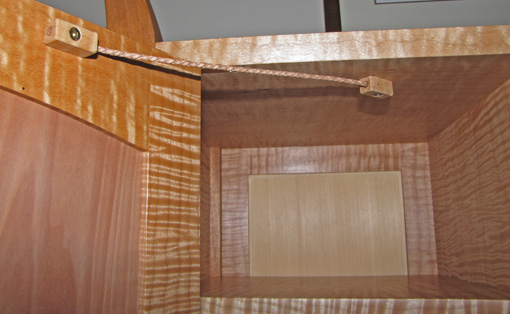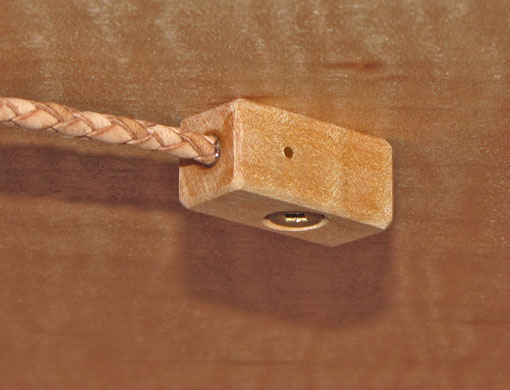
In designing cabinets and boxes, it is often necessary to limit the travel of a door or lid. Hardware options include folding stays, sliding stays, chains, and various types of supports. While some are purely practical and some more elegant, I did not feel any of the manufactured choices I was considering for this pair of small doors was in keeping with the overall nature of the piece. The problem was the metal itself – hard, noisy, overbuilt, and, well, metallic.
I wanted this component to be quiet and organic, so I did some experimenting and came up with a wood and leather concoction that functions well and complements the overall piece. It is also simple.
Braided bolo leather cord, 1/8″ diameter, in a tan color that matches the wood, is epoxied into a 1/8″ diameter hole going fully through the length of a 1″ x 7/16″ x 7/16″ maple block. To further secure the cord, a brass 0.050″ wire brad (local Ace Hardware) is gently tapped through a slightly undersized hole crossing the width of the near portion of the block and passing through the cord. The pin is clipped and filed flush at each end. A small countersunk screw attaches the block to the door or cabinet interior.

Experimentation will show where to place the blocks, considering these factors:
- the desired limit of the door opening
- a balance between putting the blocks too far away from the hinge side where the cord will be too obtrusive, and too close to the hinge side where too much leverage placed on the cord risks breaking it
- the blocks must not bump into each other when the door is closed
- there must be room for the cord to easily tuck away without curling too much when the door is closed (also, avoid twisting the cord)
- what looks right
The diameter of the cord, up to ½”, and the sizes of the blocks and fasteners would be adjusted according to the overall size of the piece. I sized the components as seemed right for these doors which are about 16″ x 10″. In testing, I was able to break the 1/8″ cord with a strong pull but it certainly is adequate for its task in this project.
I think the bit of desperation involved in the genesis of these stays ultimately helped produce a unique touch to the piece.


Hi Rob
i have been following your setting up shop blog. when can we expect to read your choice machine number 3 and 4?
regards
Thomas
Thomas,
As you go beyond the decisions for the first and second machines, for which I suggest portable thickness planer and bandsaw, respectively, the number of options decreases, there is usually more commitment to buy multiple machines, and one has a better sense of what is needed. For most woodworkers, I would suggest the options to consider are: jointer, table saw, router with router table, and dust collector.
Rob